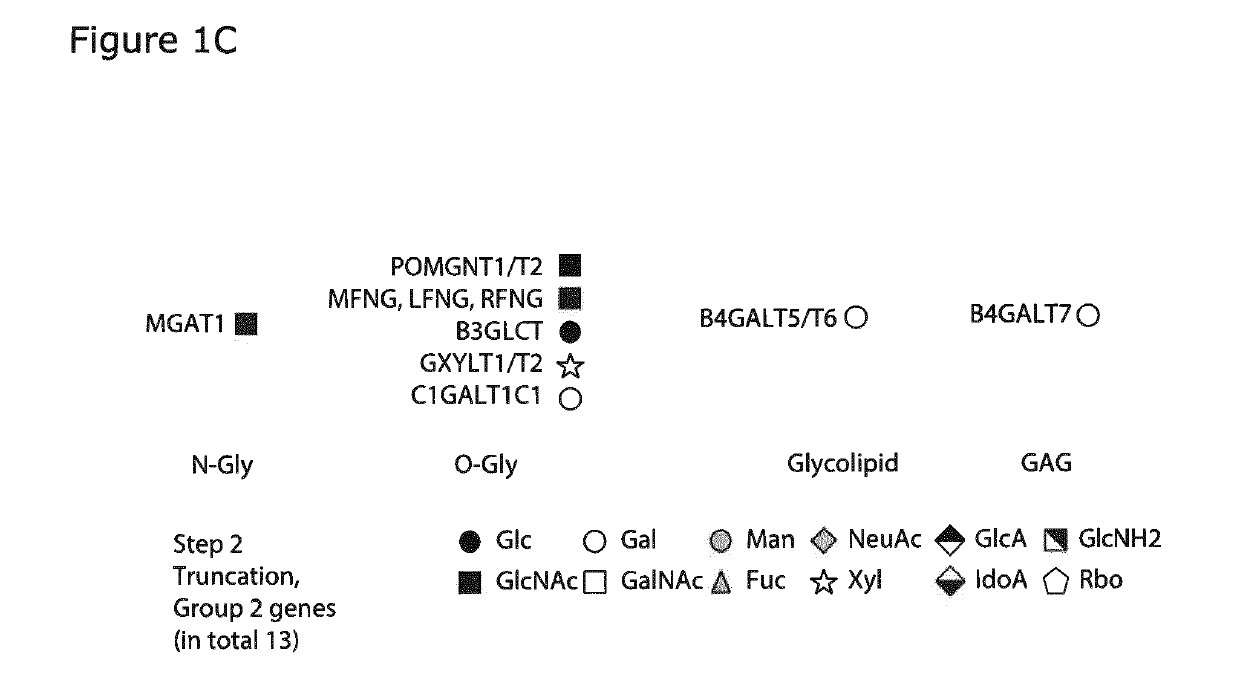A cell-based array platform
a technology of array platform and array array, applied in the field of cell-based array platform, to achieve the effect of cost-effective expansion of library complexity and volume, and cost-effectiveness
- Summary
- Abstract
- Description
- Claims
- Application Information
AI Technical Summary
Benefits of technology
Problems solved by technology
Method used
Image
Examples
example 1
Glycoengineering of Mammalian HEK293 Cells
[0417]The human HEK293 cell is the preferred cell line for transient expression of human proteins with high transfection efficiencies and at high protein production levels. Moreover, the natural glycosylation capacity of HEK293 cells is complex and includes all major types of glycoconjugates and types of protein and lipid glycosylation. Moreover, elaborations of each type of glycosylation are more diverse than many other cell types and include for example for O-GalNAc glycosylation core 2 structures and for N-linked glycosylation LacDiNAc capping structures. The present inventors used combinatorial precise gene edited knock out and knock in of human glycogenes to develop a plurality of HEK293 isogenic mammalian cells to serve as a library of cells with different capacities for glycosylation of lipids, glycoproteins and proteoglycans to provide a display platform of the human glycome in the context of endogenous HEK293 glycoconjugates. The pr...
example 2
[0435]Determining the Glycosyltransferase Repertoire Expressed in a Mammalian HEK293 Cell Line.
[0436]For transcriptome analysis HEK293 cells were seeded at 0.25×106cells / ml in 6 well plate and harvested at exponential phase 48 h post inoculation for total RNA extraction with RNeasy mini kit (Qiagen). RNA integrity and quality were checked by 2100-Bioanalyser (Agilent Technologies). Library construction and next generation sequencing was performed using Illumina HiSeq 2000 System (Illumina, USA) under standard conditions as recommended by the RNASeq service provider. The aligned data was used to calculate the distribution of reads on human reference genes and coverage analysis was performed.
[0437]The reported RNAseq analysis of the mammalian CHO-K1 (Xu 2011) was included for comparison since the cells are widely used for biopharm production of glycoproteins and accordingly the glycosylation capacity of CHO is well characterized (Yang 2015B, Xu 2011). Most orthologous human and CHO gl...
example 3
[0440]Gene Inactivation of Glycosyltransferase and Glycan Modifying Enzyme Genes in a Mammalian HEK293 Cell.
[0441]All the glycosyltransferase gene targeted inactivations were performed in HEK293 and cells were grown as described in Example 1. For ZFN and TALEN targeting cells were seeded at 0.5×106 cells / mL in T25 flask (NUNC, Denmark) one day prior to transfection. 2×106 cells and 2 pg endotoxin free plasmid DNA of each ZFN (Sigma, USA) were used for transfection. ZFN's were tagged with GFP and Crimson by a 2A linker (Duda 2015). Transfections were conducted by electroporation using Amaxa kit V and program U24 with Amaxa Nucleofector 2B (Lonza, Switzerland). Electroporated cells were subsequently plated in 3 mL growth media in a 6-well plate. Cells were moved to 30° C. for a 24 h cold shock. 72 h post nucleofection the intermediate positive cell pool for both GFP and Crimson were enriched by FACS. The present inventors utilized recent developed methods for enriching KO clones by FA...
PUM
| Property | Measurement | Unit |
|---|---|---|
| Volume | aaaaa | aaaaa |
| Volume | aaaaa | aaaaa |
| Fraction | aaaaa | aaaaa |
Abstract
Description
Claims
Application Information
 Login to View More
Login to View More - R&D
- Intellectual Property
- Life Sciences
- Materials
- Tech Scout
- Unparalleled Data Quality
- Higher Quality Content
- 60% Fewer Hallucinations
Browse by: Latest US Patents, China's latest patents, Technical Efficacy Thesaurus, Application Domain, Technology Topic, Popular Technical Reports.
© 2025 PatSnap. All rights reserved.Legal|Privacy policy|Modern Slavery Act Transparency Statement|Sitemap|About US| Contact US: help@patsnap.com



